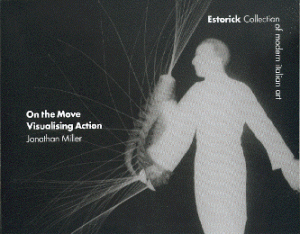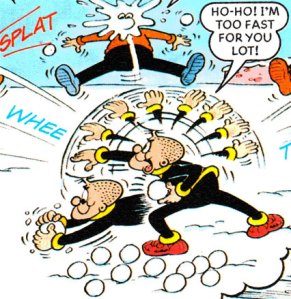
Still four weeks to go until the Estorick’s (London) exhibition finishes. On the Move: Visualising Action, by Jonathan Miller, closes 18th April. (Check their website for opening times.) A mix of 19th and 20th-century paintings, drawings, linocuts, many photographic prints, and a small selection of objects including some Muybridge lantern slides (Fancy Dancing), Animal Locomotion collotypes, and several original Zoopraxiscope colour discs. Plus: a Marey photographic gun, a Marey bronze of a seagull in flight – and replica praxinoscopes, zoetrope, phenakistiscope, and thaumatrope to play with. One small quibble – the ‘Double pulley slide’ comprising the silhouette sequence of a horse, on a small glass disc, is captioned as (from memory) not being intended for illumination or public show. In fact, this would have been used in a magic lantern (slide projector) and shown to the public on a big screen. It was sometimes known as a ‘lantern Wheel of Life’.
I was especially interested to see several photographic prints by Idris Kahn : Rising Series… After Eadweard Muybridge ‘Human and Animal Locomotion’ – manipulating Muybridge images by superimposing them, as I had not previously seen all of these. At least one other artist, Doug Keyes, has used a similar technique, but I have not seen his images. This composite technique was first used by Francis Galton for scientific purposes; he superimposed Muybridge’s galloping horse phases in 1882.
A short film about Muybridge, by Keith Hathaway, plays continuously. This semi-animates a number of Animal Locomotion images, using the lantern slide versions from the Kingston collection.
A very engaging exhibition, with excellent text by Jonathan Miller.
In the accompanying 60-page book, which does not list the individual exhibits, Jonathan Miller states: “In contrast to Muybridge – whose influence on art was largely confined to corrections of the pictorial representation of animal movement, Marey unknowingly laid the foundations for one of the most significant developments in 20th-century modernism…” A check on YouTube for Muybridge will reveal a plethora of new Muybridge-inspired pieces, mostly animations, by young artists. And the creators of many modern works to be found in galleries today – paintings, drawings, photographs, installations – cite Muybridge as their inspiration. Just as Marey influenced the artists of 20th-century modernism, Muybridge is inspiring the artists who are creating the visual media of the 21st century.


